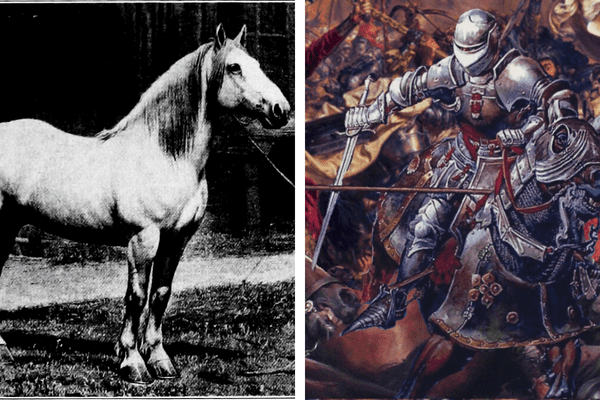Destrier Horses were an integral part of medieval history, galloping proudly through battlefields and tournaments like no other breed could before them: known for its strength, courage, and majestic presence; they have become legendary and revered steeds among knights and nobility alike.
Medieval tales often depict the destrier as the “Great Horse”, representing both chivalric valor and martial prowess. Renowned for carrying knights into battle or tournament, this noble animal often stands as the epitome of medieval war horses.
However, while destriers were held in high regard by knights and men-at-arms during the Middle Ages, they were relatively rare on actual battlegrounds and jousting arenas of that period. While its majestic presence can often be found depicted in historical texts, most mounted warriors typically relied upon other breeds like courser and rouncey horses more frequently for riding combat duties and jousting bouts.
Characteristics:
The destrier, a legendary medieval steed often associated with valiant knights, seamlessly marries raw power with elegant agility to mesmerize scholars and historians alike with its mystique. Through research and artistic depictions, its true nature, often misrepresented by its massive stature, emerges through strength training techniques as an intricate tapestry woven through research studies and artistic depictions.
Physical Attributes: Size Theories: Contrary to popular perception, destriers were typically much smaller than expected and usually stood 14-15 hands (142 to 152 cm).
Muscle and Strength: The true majesty of a destrier was not its stature but rather in its notable musculature, profound strength, and highly trained bodies for battle.
Medieval Armor Measurements: According to research at the Royal Armouries, medieval armor used during its time fits horses from 15-16 hands (152-163 cm), more similar in proportion than not to modern field hunting horses than giant war horses.
Holistic Research at the Museum of London: Employing multiple sources – literary works, pictorial artifacts and archaeological discoveries – researchers were able to establish an accurate depiction of London that differed substantially from popular depictions.
Training Over Size: A destrier’s distinctive traits lay more in its physical prowess, training and muscularity than mere size.
Italian Equestrian Sculptures: Offering an insight into historical equine aesthetics, these sculptures resemble Baroque breeds such as Andalusian or Friesian horses in terms of form.
Height Estimates: Based on current estimations, Destrier should stand no taller than 16 hands, providing for a strong yet not overbearing physique.
Misconception of “Great Horse”
The term “Great Horse” often leads to assumptions that destriers were precursors to modern draft horses; however, historical records reveal an altogether different tale: not of enormous size but remarkable strength and martial aptitude that creates an alternative view: one where destriers emerged not as massive behemoths but as brave warhorses of olden times.

Legacy Continues:
The desterre horse breed was iconic of medieval warfare and continues to leave an indelible mark today, even without actively engaging in warfare itself. Historical documents, medieval art and modern horse breeds all attest to the influence this legendary breed had during an age characterized by physical combat and noble chivalry.
Modern Equestrian Breeds Recall Historical Might
Current equestrian breeds such as Percheron and Friesian display traits characteristic of their predecessor, destriers, which were known for their sturdy build and potency.
Percheron: Originating in France, this breed displays a harmonious combination of power and temperament, likely valued in medieval knights’ armorers’ destriers.
Friesian: Hailing from the Netherlands, the Friesian features a substantial and powerful build, similar to what was described as destriers in historical texts. He serves as an effective modern embodiment of these historical breeds.
Art and Literature Preserving the Destrier
Artworks and manuscripts depicting medieval destriers show their vitality and significance during battle as well as their associations with nobility, providing a vivid reminder of how important these noble warriors were for military success and nobility.
Destrier Horses Carry Military and Noble Connotations
Though no longer actively engaged in military or social activities for which they once played an essential part, destriers remain iconic symbols from medieval times era when horses were central players in combat and social life. Their legacy lives on in historical discussions and studies while further solidifying its relevance within historical studies.
Overall, the destrier remains a powerful symbol in historical analysis, upholding and perpetuating its legacy of power, nobility and military importance through modern horse breeds and preserved artworks that showcase its physical existence and continue to shape our perception of medieval history and equine development.

